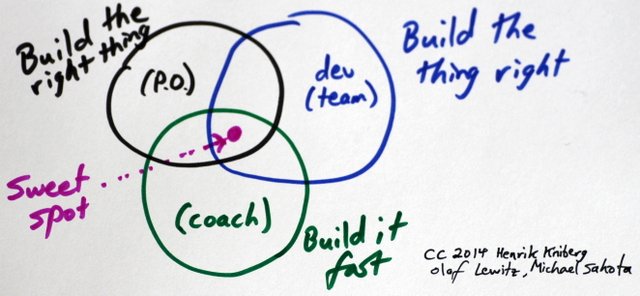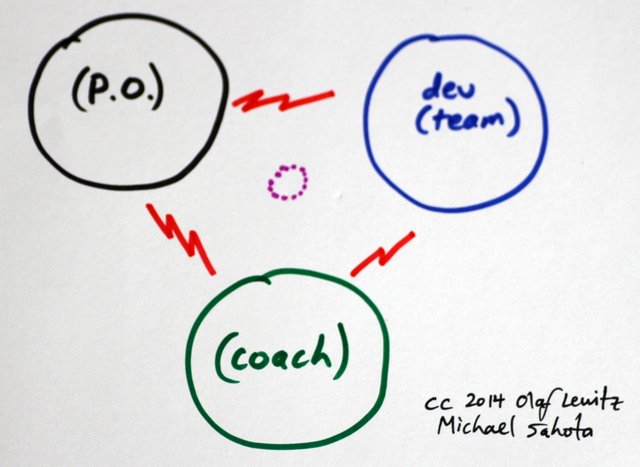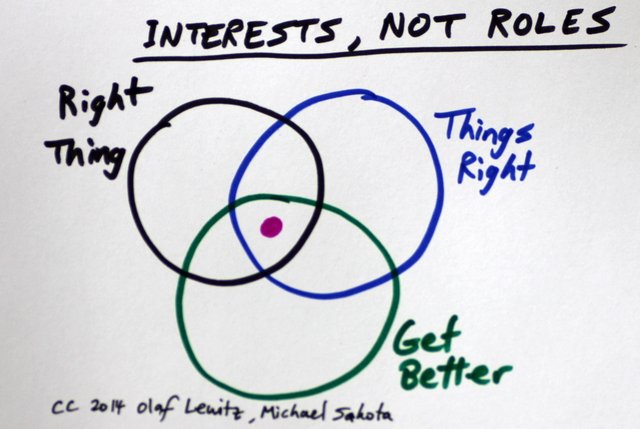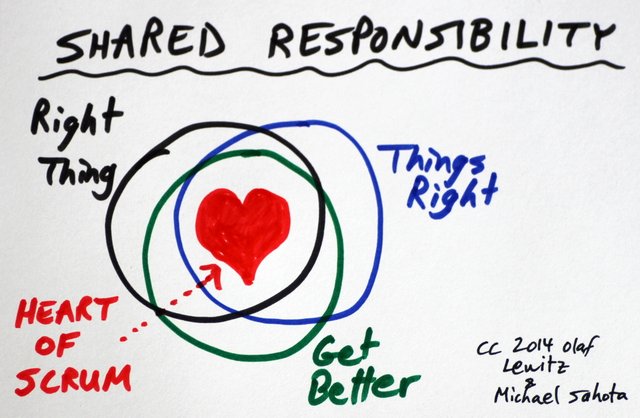In this post we will explain how we can move to shared responsibility by focusing away from roles in Scrum.
(This is a joint post with Olaf Lewitz).
Build the Right thing. Build it Right. Build it Fast. ?
Henrik Kniberg produced a kick-ass intro video on Agile and Scrum that we use a lot in trainings. It’s titled “Agile Product Ownership in a Nutshell”. It’s a great general introduction to Scrum, not just for Product Owners.
One amazing detail in this video is Henrik’s visualisation that helps understand three project goals and how the three Scrum Roles relate tend to focus on each:
He highlights how Scrum teams continually get better at finding and exploiting the sweet spot, of doing the right thing in the right way at the right point in time.
A Problem with Roles
We were using this model in a training and a participant in a training inspired us with a question: “What if these circles are closer together or further apart? There is no sweet spot any more if they don’t share these responsibilities…”
We noticed that the word “role” is actually not helpful in this context. A role is a “not my problem” rule. (cf Somebody Else’s Problem)
A team employing the traditional “role interpretation” to Scrum roles would look like this:
They will have a hard time finding a sweet spot on their own, and they might choose doing what they are told: deliver on expectations. Such an environment has a low probability to continually improve.
Roles have been useful in the past, when organisations were structured based on one proven way to do things. In today’s ever-changing business contexts, following an established process, having clear roles and responsibilities, is limiting our options. One example is blame: “He is responsible for that, so it’s not my fault.” When we want to enable a group of people to discover a path to success, having shared responsibility for the outcome, it’s helpful to use a different language that focuses our awareness on the new game we’re playing.
Value Interests over Roles
We want to talk about interests instead of roles:
Do the right thing.
Do things right.
Get better and better every day.
Positions not Roles
We may think about positions like on a team: forward, mid-field, defense where we all work together to win. This is a more useful and less limiting model than roles.
In soccer, we’ve seen goalkeepers score in the 92nd minute. When the goalkeeper falls other players help keeping the ball out of the goal. This is the behaviour we want to see in teams.
The Heart of Scrum: Shared Responsibility
When we focus as a group on these shared interests, we may end up as shown below.
As collaboration and shared responsibility increases, teams explore multiple beneficial sweet spots to have an abundance of options for success. We see this as a huge “sweet blob” in the middle where – we call this the Heart of Scrum. For us, this means the group fully works together as a team towards a common goal.
Acknowledgements
A big thanks for Henrik Kniberg for creating such an awesome and valuable video. We would like to thank Tobias Mayer for inspiring this concept with the People’s Scrum and Krishan Mathis for co-facilitating a session with the same name at OOP.






